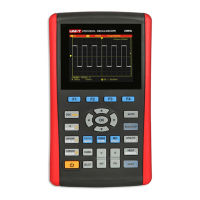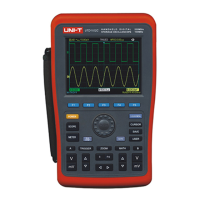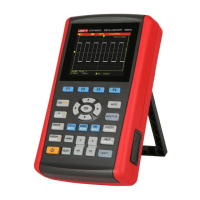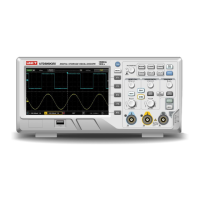
Do you have a question about the UNI-T UTD1025CL and is the answer not in the manual?
| Type | Digital Storage Oscilloscope |
|---|---|
| Bandwidth | 25 MHz |
| Sample Rate | 250 MS/s |
| Channels | 2 |
| Display Resolution | 320 x 240 pixels |
| Weight | 2.5 kg |
| Input Coupling | AC, DC, GND |
| Trigger Modes | Auto, Normal, Single |
| Timebase Range | 5 ns/div to 50 s/div |
| Trigger Types | Edge, Pulse, Video |
| Power | 100-240 VAC, 50/60 Hz |
| Vertical Resolution | 8 bit |
| Input Impedance | 1 MΩ |
| Input Voltage Range | 400 V (DC + AC peak) |
| Max Input Voltage | 400 V (DC + AC peak) |
Explains terms and symbols used in the manual and on the product for safety.
Covers design standards, safety measures, and general precautions for safe operation.
Lists and describes the components included with the oscilloscope.
Highlights key features and capabilities of the oscilloscope.
Outlines steps for performing a general check of the oscilloscope before use.
Guides users on checking the included accessories for completeness and condition.
Explains how to connect the oscilloscope and lists interface port functions.
Explains the two power supply methods for the oscilloscope.
Describes how to manually adjust the vertical system settings on the oscilloscope.
Details manual adjustments for the horizontal system, including time base.
Explains how to set and adjust the trigger level on the oscilloscope.
Introduces the multimeter function of the oscilloscope.
Describes the input ports for multimeter measurements.
Explains the indications shown on the multimeter interface.
Introduces the chapter on oscilloscope functions and operations.
Details the settings for the vertical system, including channel setup.
Details how to adjust the time base and scanning velocity of the oscilloscope.
Explains how to adjust the horizontal position to view pretrigger information.
Details trigger modes, source, coupling, and general settings.
Explains the input channel used as the trigger information source.
Describes automatic, normal, and single trigger modes.
Explains signal transmission to the trigger circuit with DC, AC, and HF restriction.
Explains how to access the waveform record function and its menus.
Details the method for measuring voltage or time between two cursors.
Provides solutions for issues where the oscilloscope fails to power on.
Addresses problems with the oscilloscope shutting down shortly after starting.
Troubleshoots significant discrepancies in measured voltage amplitude.
Offers steps to resolve issues when waveforms do not appear after signal collection.
Provides guidance on troubleshooting unstable waveform displays.
Addresses the issue of no display after using the RUN/STOP key.
Explains why display speed may slow down after enabling average acquisition.
Discusses troubleshooting echelonment display issues by changing display type.
Describes methods for acquiring and performing program upgrades.
Outlines necessary preparations before upgrading the oscilloscope's software.
Lists the conditions that must be met for program upgrades.
Lists the technical specifications and performance indices of the oscilloscope.
Details the power specifications, including voltage, current, and battery.
Lists operating conditions, dimensions, weight, and IP protection rating.
Specifies the recommended calibration interval.
Provides guidelines for maintaining, storing, and cleaning the instrument safely.












